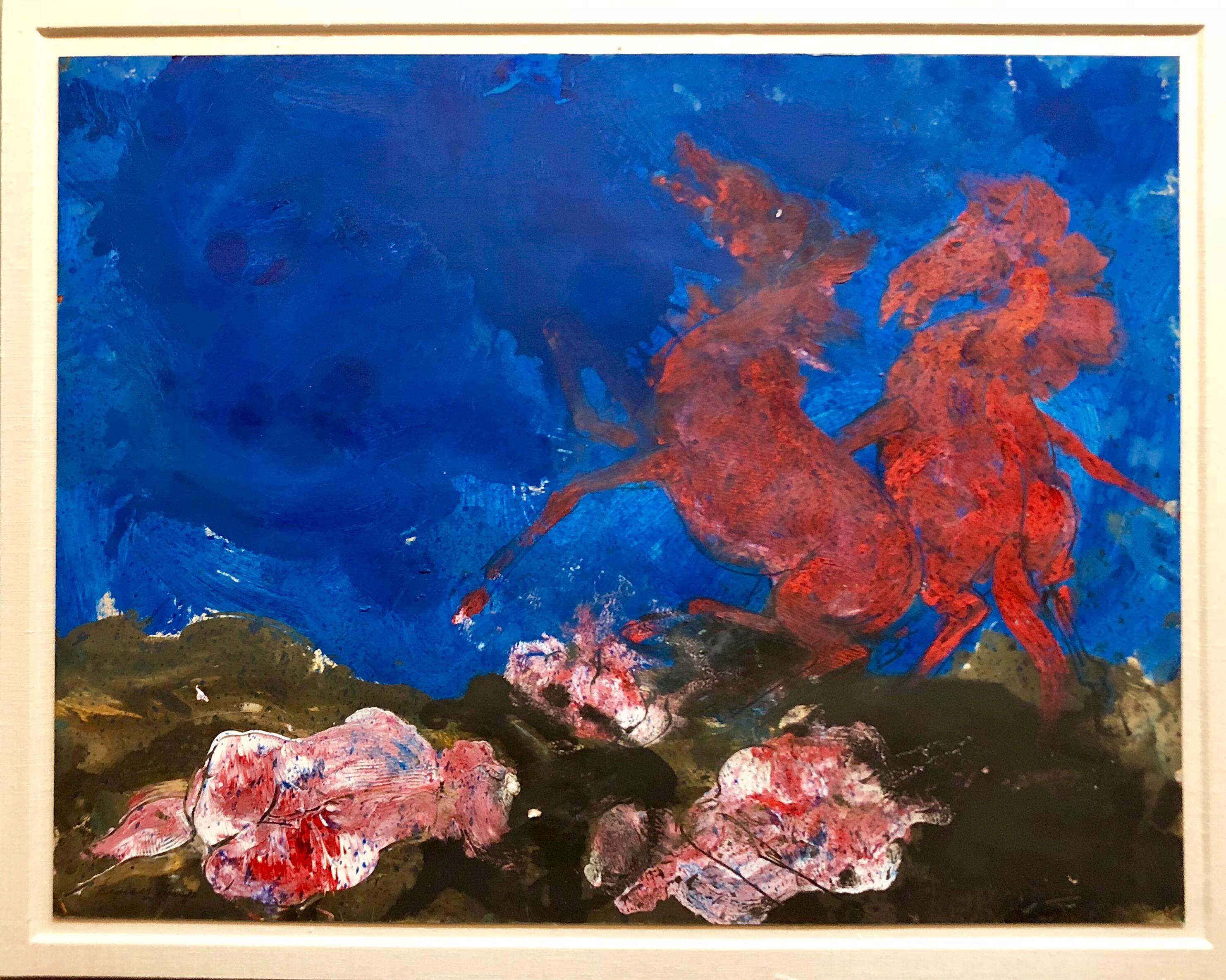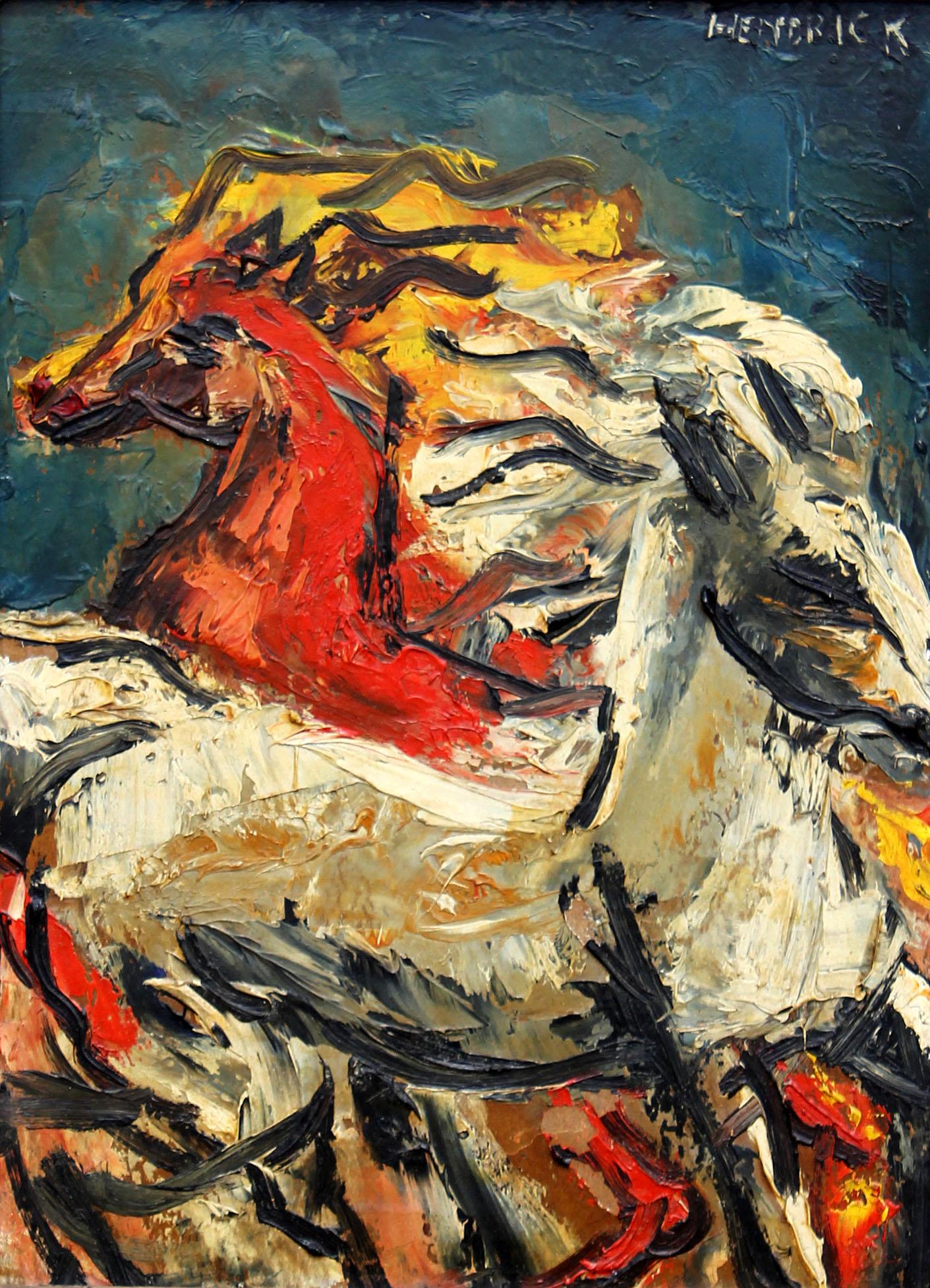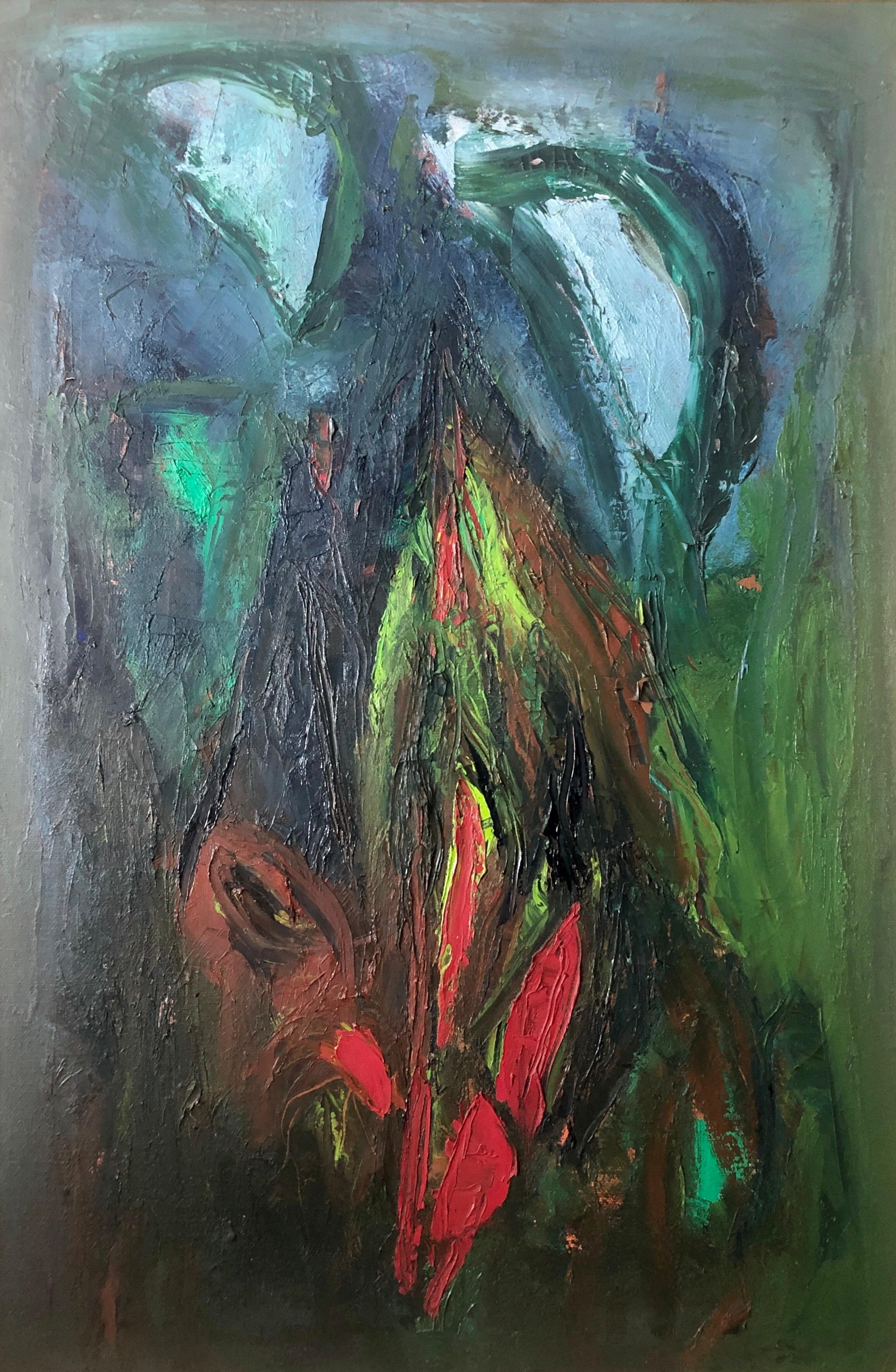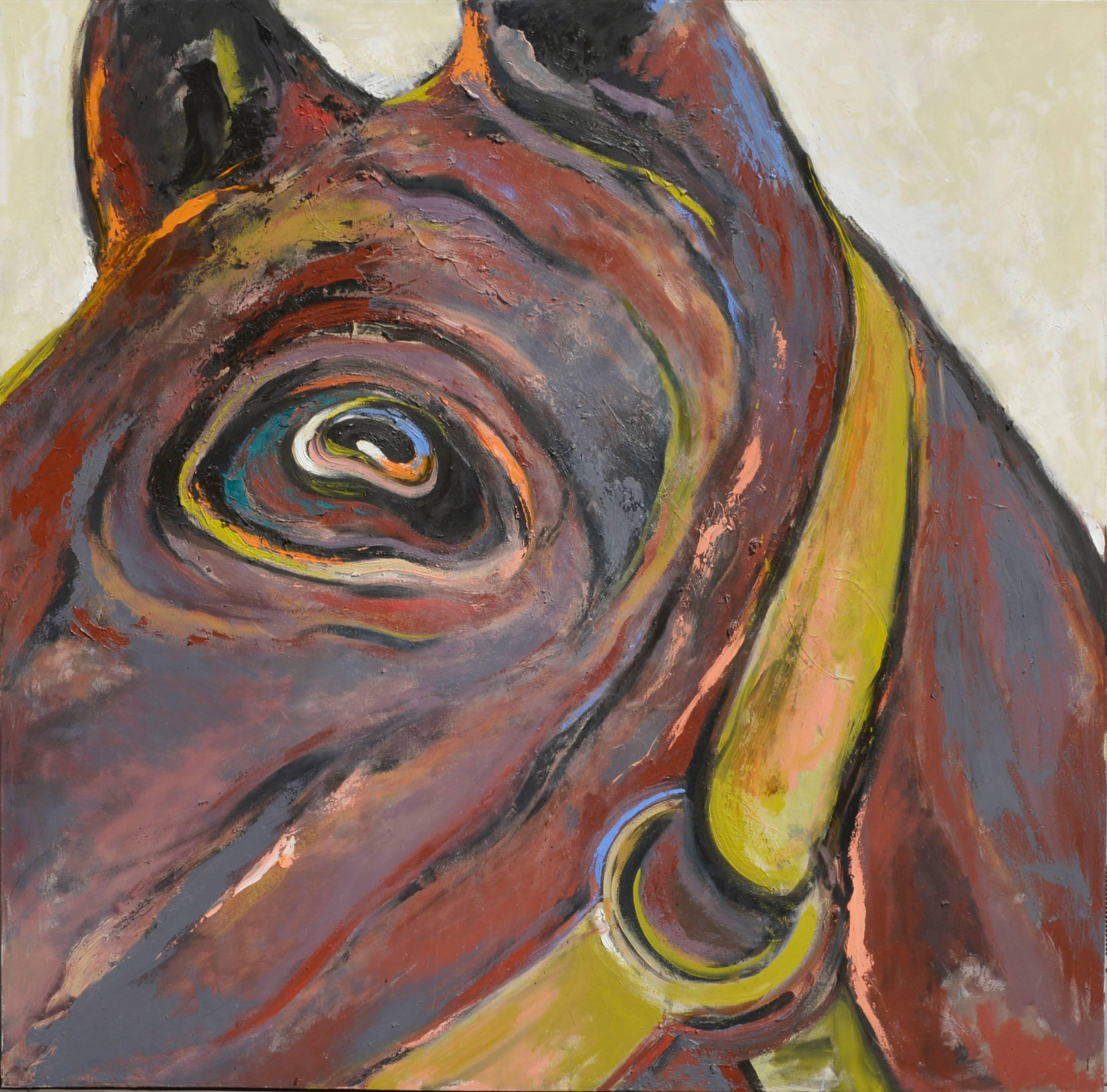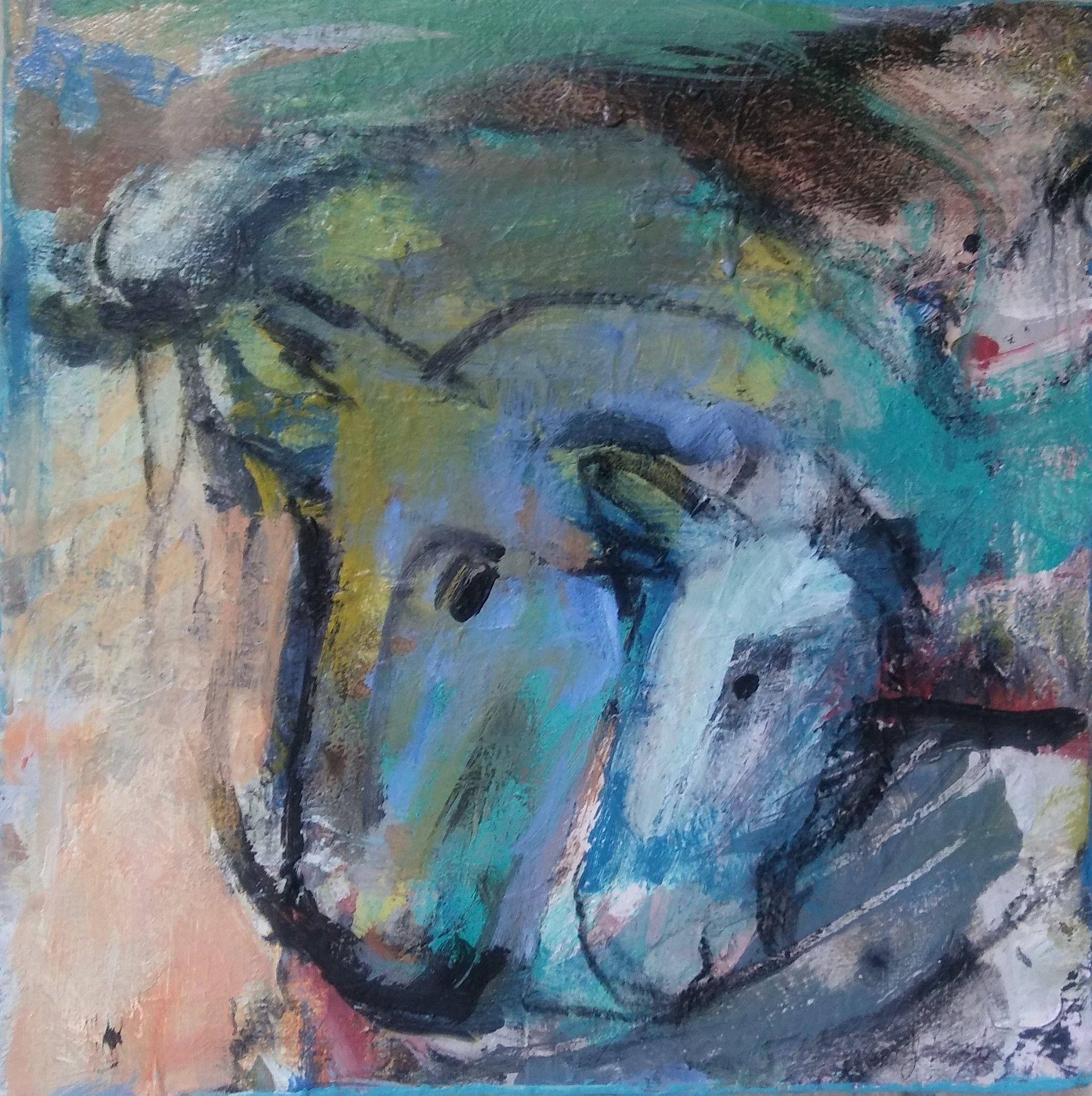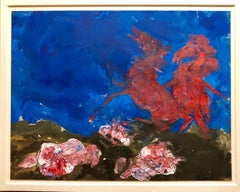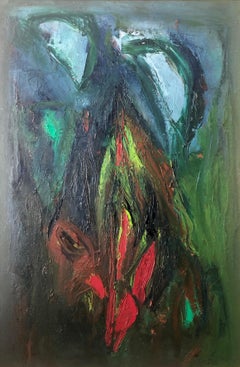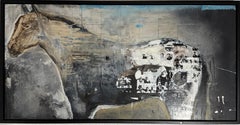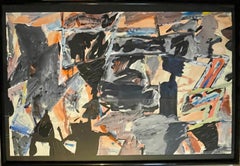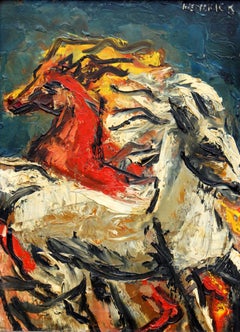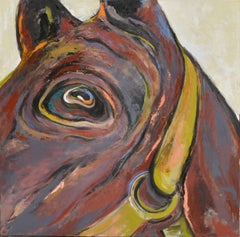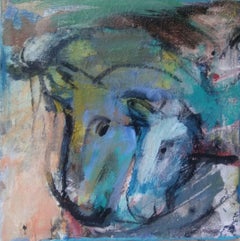Items Similar to American Neo Expressionist "Wild Horses" Modernist Oil Painting
Want more images or videos?
Request additional images or videos from the seller
1 of 10
Robert BeauchampAmerican Neo Expressionist "Wild Horses" Modernist Oil Painting
$2,800
£2,138.92
€2,457.41
CA$4,003.40
A$4,410.81
CHF 2,283.30
MX$53,107.32
NOK 28,912.14
SEK 27,161.13
DKK 18,349.23
About the Item
Signed lower left.
Robert Beauchamp (1923 – March 1995) was an American figurative painter and arts educator. Beauchamp's paintings and drawings are known for depicting dramatic creatures and figures with expressionistic colors. His work was described in the New York Times as being "both frightening and amusing,". He was a Guggenheim Fellow and a student of Hans Hofmann.
Robert Beauchamp was born in Denver, Colorado in 1923. He had three brothers and three sisters, and the children were orphaned by both parents by the time Beauchamp was three. The family grew up impoverished due to the Great Depression, living in a community house with other families. As a child he dabbled in art but it wasn't until high school that he began taking art classes. When not creating art he also played sports; football and basketball, and enjoyed chemistry and geology.
He was told he was good at drawing, and replaced study hall classes with art classes, receiving instruction and inspiration from a Welsh teacher named R. Idris Thomas. While in high school Beauchamp would go, every Monday, to the public library and a local museum where he would read books about art; specifically French painting, as assigned by Thomas. Beauchamp absorbed the tenets of European Modernism and American Abstract Expressionism—with which he eventually broke. While abstraction, with its focus on color and form, underlies his compositions, he filled canvas and paper with psychologically acute portraits of himself and others, nudes, animals, and objects of all kinds. Beauchamp would spend upwards of four hours a day in the art room and eventually won the Carter Memorial Prize, which provided a scholarship to the Colorado Springs Fine Arts Center. At Colorado Springs he studied under Boardman Robinson, painting landscapes in nature.
Beauchamp eventually joined the Navy and then returned to Colorado Springs to continue his studies. Traveling the world as an Armed Guard, he spent a year and a half at sea and the rest of the three years in San Francisco. Seeking to make money, and to follow his love for a girl, Beauchamp decided to attend Cranbrook Academy of Art from 1947–1948. There he studied pottery, believing one could "make more money selling pots than you could selling paintings." He described his experience at Cranbrook as intimidating and claustrophobic, and eventually switched to sculpture before switching to painting.
Beauchamp moved to New York City in the early 1950s and was involved in the Tenth Street galleries, which provided outlets for more experimental artists and the second generation of abstract expressionists. Despite his involvement with 10th Street and friendships with abstract artists, abstract art never interested in him. He showed at numerous galleries in New York and Provincetown, socializing with gallery owners, artists and collectors. His first exhibition was at the Tanager Gallery in New York, he also showed during the 1950s at the Hansa Gallery. In New York and Provincetown he studied under Hans Hofmann Eventually he felt that abstract expressionism became dull and stalemated.
During the 1960s he showed at the Green Gallery. C. 1960 he was awarded a Fulbright Award allowing him to travel to La Romola, Italy. He traveled frequently to cities such as Rome and worked constantly. Beauchamp returned to the states and lived in Provincetown at Walter Gutman's house, who awarded Beauchamp a grant. That year he met his future wife, Nadine Valenti, whom he married in 1967. Beauchamp taught at a variety of schools during his lifetime including Brooklyn College, School of Visual Arts, Cooper Union and the Art Students League of New York during the last fifteen years of his life.
Beauchamp described his drawings as painterly, seeking the spontaneity in an image. He would develop a drawing then a painting, and vice versa. His heavily impastoed paintings, often described as sculptures themselves, came from the pouring of paint from a can, with little planning and constant evolution in the medium upon the canvas. He preferred little planning to his creations, believing that an artists work would become stale and repetitive with constant planning.
He also created large scale works, at times 70 inches long. Beauchamp had little intention of ever selling his large works, preferring to create them due to the slow and intense experience he received from the process. The large drawings he created on the floor, and the smaller works were created on a table. Paintings were created on either the floor or wall and he described his painting process as "splattering", "pushing the paint around," and sponging.
Animals often appear in his paintings, despite a dislike for domestic animals outside of his artistic creations. He called the characters in his paintings as Beauchamps. Some Beauchamps hold meaning, with Beauchamp rarely sharing the meaning behind the symbols and characters. He made up the creatures himself, seeking to emphasize the character of each.
In 2006 the University of Massachusetts Amherst College of Visual & Performing Arts hosted an exhibition of Beauchamp's pieces from the 1960s, curators stated that Beauchamp's work: "effortlessly blends innovative style elements with narrative, descriptive images. One senses equal enjoyment in the manipulation of, and interaction with, color and paint, and the often sudden and unexpected presence of a wasp or a lump of sugar."
included in the important exhibit "Twelve New York Painters." New York: David Findlay Jr. Fine Art with Mary Abbott, Alcopley, Robert Beauchamp, Byron Browne, Charles Cajori, Jim Forsberg, Carl Heidenreich, Angelo Ippolito, Emily Mason, Robert Natkin, Robert Richenburg and Nina Tryggvadottir.
He was associated with The Rhino Horn Group of notable artists, Benny Andrews, Jay Milder, Peter Dean, Leonel Góngora, Red Grooms and Lester Johnson were all associated with it as well. There was a collective emphasis on depicting the human condition as subject matter, criticizing social ills and cultural myopia, and encouraging a range of emotional responses. The existence of Rhino Horn (throughout the 60’s and 70’s) contradicts the narrative in many art historical texts that Neo-Expressionism in the late 1970s was the return to mythological, audacious and boldly charged figurative painting. It underscores a lineal continuity of American Figurative Expressionism from the 1950s onward.
Select Notable Exhibitions
Felix Landau Gallery
Guggenheim Museum
David Findlay Jr Fine Art, New York, NY (solo)
The Artful Jester, Brattleboro Museum & Art Center, Brattleboro, VT
Beauregard Fine Art Gallery, Rumson, NJ (solo)
Acme Gallery, Boston, MA (solo)
Figurative Expressionists of Provincetown, Berta Walker Gallery, Provincetown, MA
Fantasy and Angst in the Art of Robert Beauchamp, Boston Psychoanalytic Society and Institute, Boston, MA (solo)
The Kind and the Fool Walk in the Rain, Iris & B Gerald Cantor Art Gallery, College (solo)
M-13 Gallery, New York, NY (solo)
Longpoint Gallery, Provincetown, MA
Monique Knowlton Gallery, New York, NY
Andre Zarre Gallery, New York, NY (solo)
Vanderwoude-Tannenbaum Gallery, New York, NY (solo)
Locus Gallery, San Antonio, TX (solo)
Phoenix Gallery, Provincetown, MA (solo)
Gruenbaum Gallery, New York, NY (solo)
Fay Gold Gallery, Atlanta, GA (solo)
Lamar Dodd Museum, La Grange, GA (solo)
Cranbrook Academy of Art Museum, Bloomfield Hills, MI
Terry Dintenfass Gallery, New York, NY (solo)
Ten Independents, Guggenheim Museum of Art, New York, NY
Simone Sterne Gallery, New Orleans, LA (solo)
Louisiana State University, Baton Rouge, LA (solo)
Tirca Karlis Gallery, Provincetown, MA (solo)
Whitney Museum of Art, Biennial, New York, NY
Obelisk Gallery, Boston, MA (solo)
Richard Gray Gallery, Chicago, IL (solo)
Museum of Modern Art, New York, NY
Zabriskie Gallery, New York, NY
Tanager Gallery, New York, NY
Martha Jackson Gallery, New York, NY
St. Marks in the Bowery Gallery, New York, NY
March Gallery, New York, NY
Stable Gallery, New York, NY
Walker Art Institute, Minneapolis, MN
Select Public Collections
Provincetown Art Association & Museum, Provincetown, MA
Cape Fine Arts Museum, Dennis, MA
University of Nebraska, Sheldon Memorial Art Gallery & Sculpture Garden, Lincoln, NE
Boston Museum of Fine Arts, Boston, MA
University of California at Berkeley, CA
American Federation of Arts, Museum Purchase Fund, New York, NY
Hecksher Museum, Huntington, NY
University of Texas at Austin, Austin, TX
The Seattle Museum of Art, Seattle, WA
The Metropolitan Museum of Art, New York, NY
The Whitney Museum of Art, New York, NY
The Museum of Modern Art, New York, NY
The Hirshhorn Museum & Sculpture Garden, Washington, DC
The Carnegie Institute, Pittsburgh, PA
The Brooklyn Museum of Art, Brooklyn, NY
The National Gallery, Washington, DC
The Denver Museum of Art, Denver, CO
Dow Jones
Estee Lauder
The Aldrich Museum of Contemporary Art, Ridgefield, CT
University of Massachusetts at Amherst, Amherst, MA
- Creator:Robert Beauchamp (1923 - 1995, American)
- Dimensions:Height: 26.5 in (67.31 cm)Width: 33 in (83.82 cm)
- Medium:
- Movement & Style:
- Period:
- Condition:size includes mat. mounted to matting small studio losses to corners. in good studio condition.
- Gallery Location:Surfside, FL
- Reference Number:1stDibs: LU38213082932
About the Seller
4.9
Platinum Seller
Premium sellers with a 4.7+ rating and 24-hour response times
Established in 1995
1stDibs seller since 2014
1,817 sales on 1stDibs
Typical response time: 1 hour
- ShippingRetrieving quote...Shipping from: Surfside, FL
- Return Policy
Authenticity Guarantee
In the unlikely event there’s an issue with an item’s authenticity, contact us within 1 year for a full refund. DetailsMoney-Back Guarantee
If your item is not as described, is damaged in transit, or does not arrive, contact us within 7 days for a full refund. Details24-Hour Cancellation
You have a 24-hour grace period in which to reconsider your purchase, with no questions asked.Vetted Professional Sellers
Our world-class sellers must adhere to strict standards for service and quality, maintaining the integrity of our listings.Price-Match Guarantee
If you find that a seller listed the same item for a lower price elsewhere, we’ll match it.Trusted Global Delivery
Our best-in-class carrier network provides specialized shipping options worldwide, including custom delivery.More From This Seller
View AllAmerican Neo Expressionist "Wild Horses" Modernist Oil Painting
By Robert Beauchamp
Located in Surfside, FL
Robert Beauchamp (1923 – March 1995) was an American figurative painter and arts educator. Beauchamp's paintings and drawings are known for depicting dramatic creatures and figures with expressionistic colors. His work was described in the New York Times as being "both frightening and amusing,". He was a Guggenheim Fellow and a student of Hans Hofmann.
Robert Beauchamp was born in Denver, Colorado in 1923. He had three brothers and three sisters, and the children were orphaned by both parents by the time Beauchamp was three. The family grew up impoverished due to the Great Depression, living in a community house with other families. As a child he dabbled in art but it wasn't until high school that he began taking art classes. When not creating art he also played sports; football and basketball, and enjoyed chemistry and geology.
He was told he was good at drawing, and replaced study hall classes with art classes, receiving instruction and inspiration from a Welsh teacher named R. Idris Thomas. While in high school Beauchamp would go, every Monday, to the public library and a local museum where he would read books about art; specifically French painting, as assigned by Thomas. Beauchamp absorbed the tenets of European Modernism and American Abstract Expressionism—with which he eventually broke. While abstraction, with its focus on color and form, underlies his compositions, he filled canvas and paper with psychologically acute portraits of himself and others, nudes, animals, and objects of all kinds. Beauchamp would spend upwards of four hours a day in the art room and eventually won the Carter Memorial Prize, which provided a scholarship to the Colorado Springs Fine Arts Center. At Colorado Springs he studied under Boardman Robinson, painting landscapes in nature.
Beauchamp eventually joined the Navy and then returned to Colorado Springs to continue his studies. Traveling the world as an Armed Guard, he spent a year and a half at sea and the rest of the three years in San Francisco. Seeking to make money, and to follow his love for a girl, Beauchamp decided to attend Cranbrook Academy of Art from 1947–1948. There he studied pottery, believing one could "make more money selling pots than you could selling paintings." He described his experience at Cranbrook as intimidating and claustrophobic, and eventually switched to sculpture before switching to painting.
Beauchamp moved to New York City in the early 1950s and was involved in the Tenth Street galleries, which provided outlets for more experimental artists and the second generation of abstract expressionists. Despite his involvement with 10th Street and friendships with abstract artists, abstract art never interested in him. He showed at numerous galleries in New York and Provincetown, socializing with gallery owners, artists and collectors. His first exhibition was at the Tanager Gallery in New York, he also showed during the 1950s at the Hansa Gallery. In New York and Provincetown he studied under Hans Hofmann Eventually he felt that abstract expressionism became dull and stalemated.
During the 1960s he showed at the Green Gallery. C. 1960 he was awarded a Fulbright Award allowing him to travel to La Romola, Italy. He traveled frequently to cities such as Rome and worked constantly. Beauchamp returned to the states and lived in Provincetown at Walter Gutman's house, who awarded Beauchamp a grant. That year he met his future wife, Nadine Valenti, whom he married in 1967. Beauchamp taught at a variety of schools during his lifetime including Brooklyn College, School of Visual Arts, Cooper Union and the Art Students League of New York during the last fifteen years of his life.
Beauchamp described his drawings as painterly, seeking the spontaneity in an image. He would develop a drawing then a painting, and vice versa. His heavily impastoed paintings, often described as sculptures themselves, came from the pouring of paint from a can, with little planning and constant evolution in the medium upon the canvas. He preferred little planning to his creations, believing that an artists work would become stale and repetitive with constant planning.
He also created large scale works, at times 70 inches long. Beauchamp had little intention of ever selling his large works, preferring to create them due to the slow and intense experience he received from the process. The large drawings he created on the floor, and the smaller works were created on a table. Paintings were created on either the floor or wall and he described his painting process as "splattering", "pushing the paint around," and sponging.
Animals often appear in his paintings, despite a dislike for domestic animals outside of his artistic creations. He called the characters in his paintings as Beauchamps. Some Beauchamps hold meaning, with Beauchamp rarely sharing the meaning behind the symbols and characters. He made up the creatures himself, seeking to emphasize the character of each.
In 2006 the University of Massachusetts Amherst College of Visual & Performing Arts hosted an exhibition of Beauchamp's pieces from the 1960s, curators stated that Beauchamp's work: "effortlessly blends innovative style elements with narrative, descriptive images. One senses equal enjoyment in the manipulation of, and interaction with, color and paint, and the often sudden and unexpected presence of a wasp or a lump of sugar."
included in the important exhibit "Twelve New York Painters." New York: David Findlay Jr. Fine Art with Mary Abbott, Alcopley, Robert Beauchamp, Byron Browne, Charles Cajori, Jim Forsberg, Carl Heidenreich, Angelo Ippolito, Emily Mason, Robert Natkin, Robert Richenburg and Nina Tryggvadottir...
Category
20th Century Neo-Expressionist Abstract Paintings
Materials
Paper, Oil
Large Colorful MCM Abstract Expressionist Oil Painting Modernist Ralph Rosenborg
By Ralph Rosenborg
Located in Surfside, FL
Ralph Rosenborg (American, 1913-1992) Mountain Weed with Two Clouds, oil on jute canvas, canvas is hand signed recto and verso, artists label and Snyder Fine Art gallery label, The p...
Category
1960s Abstract Expressionist Abstract Paintings
Materials
Canvas, Jute, Oil
Large Jack Balas Contemporary Modernist Horse Enamel & Oil Painting Western Art
By Jack Balas
Located in Surfside, FL
Jack Balas
Grid Study, Appaloosa
Oil and Enamel on Board
Inscribed verso, dated 1997-99 and hand signed l.l.
Sight: 24 x 48 in. (61 x 121.9 cm.), Frame: 26 x 50 x 2 in. (65.4 x 127 ...
Category
1990s American Realist Animal Paintings
Materials
Enamel
Large Harry Bertschmann Swiss American Abstract Expressionist Outsider Painting
By Harry Bertschmann
Located in Surfside, FL
Harry Bertschmann (Swiss American, born 1931).
Acrylic painting on paper.
Artist signature to lower right.
Provenance: Joy Moos Gallery (this was exhibited at the Outsider Art Fair)
...
Category
20th Century Abstract Expressionist Abstract Paintings
Materials
Paper, Acrylic
Untitled Dynamic Colorful Abstract Expressionist Oil Painting, Israeli-American
Located in Surfside, FL
Nachume Miller (1949–1998) was a German born Israeli artist who immigrated to New York City in 1973, where he made a name for himself in the American Modern Art scene. Miller immigrated to New York to study at the School of Visual Arts, where he would later become a professor of painting and drawing. He was quickly identified as a star on the rise and at the age of 29, was included in the Guggenheim Museum’s “Young American Artists,” Exxon National Exhibition. A decade later he was granted a solo show at the Museum of Modern Art, where his work is now part of the permanent collection. Though his career was cut short by his untimely death in 1998, Nachume exhibited at some of the most prominent galleries in New York and around the world.
Miller's parents were both Holocaust survivors. His father was a captain in the front lines of the Russian Army during World War II and his mother was a Lithuanian who had once been held captive in a concentration camp. Both escaped the Nazis, re-united and fled to Israel. Nahum was born during their voyage, in Frankfurt, Germany, on January 28, 1949. He grew up in the town of Holon, Israel, where he was inspired by his father who spent most of his post-war days carving elaborate wood sculptures of Cubist human forms. Nachum, on the contrary, excelled in painting.
By the age of 16, Miller was painting elaborate surreal dream lands referencing religion, politics and the history of Modern Art. His earlier works show similarities to Hieronymus Bosch, Salvador Dali and Francisco Goya. Miller was enlisted in the Israeli Army where he worked as one of Ariel Sharon's personal assistants and also fought in the 1973 Yom Kippur War. He went to New York in 1966 to study at the School of Visual Arts, and joined the faculty in 1977 to teach painting and drawing. He was enlisted in the Israeli Army and fought in the 1973 Yom Kippur War. That same year, he received a scholarship from the Israeli-American Cultural Foundation. He married his girlfriend Ruth and moved to New York to study at the School of Visual Arts. In 1977, he joined the faculty to teach painting and drawing.
Over the next two decades, Nachume was prolific in the range of media, styles, and references he incorporated into his art. His paintings and three-dimensional works pay homage to artists throughout history, from the classical Greeks to Robert Rauschenberg. He prioritized craft over concept and was a disciplined painter, never neglecting workmanship in favor of a trend. His work is marked with curiosity, sincerity and intensity.
Cara McCarty, an assistant curator in the department of architecture and design, organized the current show. It reveals Mr. Miller as someone who finds common ground with both Turner and Jackson Pollock - with the former's Romantic re-creations of storms at sea and with the latter's search for content in abstract gesture.
Selected One-Person Exhibitions
1976: "Drawing Show", Bertha Urdang Gallery, New York
1981: "Figures", A&M Artwork, New York
1988: Exit Art, New York; "Projects: Nachume Miller", Museum of Modern Art, New York
1989: E.M. Donahue Gallery, New York
1990: "Nachume Miller: Views", E.M. Donahue Gallery, New York
1993: "Sensual Painting", E.M. Donahue Gallery, New York
1994: The Genia Schreiber University Art Gallery, Tel Aviv University
Selected Group Exhibitions
1968: "10+ For and Against", Tel Aviv
Aviva Uri, Michael Druks, Nahum Miller, Izzika Gaon, Izzika Raffi Lavie.
1970: "10+ In a Circle", Tel Aviv
Moshe Gershuni, Buky Schwartz, Igael Tumarkin, Reuven Kadim (Berman),
1972: "Symbols and Imagination", Artists' Pavilion, Tel Aviv; "July '72", Gallery 220, Tel-Aviv
1975: "The Work of Nine Graduates of the School of Visual Arts", New York; 112 Greene Street Gallery, New York; "Group Indiscriminate", 112 Green Street Gallery, New York
1976: "8 Israeli Artists", Bertha Urdang Gallery, New York
1978: "Young American Artists", Exxon National Exhibition, Guggenheim Museum, New York
1979: The Kadishman Connection Israel Museum, Jerusalem
Menashe Kadishman, Larry Abramson, Yaacov Agam, Nachum Miller, Jacob El Hanani,Samuel Bak, Koki Doktori...
Category
1990s Abstract Expressionist Abstract Paintings
Materials
Canvas, Oil
Large Colorful 1980s New York Abstract Expressionist Oil Painting Joan Thorne
By Joan Thorne
Located in Surfside, FL
This is a large colorful, bold, vibrant original oil painting on canvas, hand signed and dated 1989.
It is titled Crete.
Joan Thorne (1943-) is a New York artist nationally and internationally recognized. A third generation Abstract Expressionist woman artist who has exhibited works over the past 30 years. Her art has been shown in the Corcoran Gallery of Art, Washington, DC, the Whitney Museum’s Annual Exhibition, the Grand Palais in Paris, and Barbara Rose’s seminal exhibition American Painting: The Eighties at New York University’s Grey Gallery.
Her recent shows in New York City have been reviewed by the New York Times, Art in America, ArtNews and The New Criterion among others. Her work has been compared to Elizabeth Murray work. It is colorful and has a 1980's, Memphis Milano feel to it.
Thorne grew up in Greenwich Village. Her mother was a Ukrainian immigrant from a musical family, who became an English teacher; her father, a surgeon. Recognizing their daughter’s artistic talents early, they enrolled her at age six in the Little Red Schoolhouse on Bleecker Street in Greenwich Village. Founded in 1921 by Elisabeth Irwin, a pioneer in educational reform, the school has continued to maintain its reputation as a progressive and nurturing catalyst for creative children. Pete Seeger, the folk singer, performed there so frequently that Thorne remembered him as if he were one of the teachers. In 1971, Thorne met Faith Ringgold (b. 1930) and joined her as a teacher at the Women’s House of Detention on Rikers Island in a new program called “Art without Walls–Free Space.” The program, which had been born from the civil rights movement, was aimed at enriching the lives of the inmates. Thorne and her peers came of age struggling against sexism in the art establishment and its attendant lack of exhibition opportunities for women. Since 1985, this issue had been loudly exposed by the public protests of the Guerrilla Girls, whose members remain a well-kept secret.
Her painting has been included in two Whitney Museum Biennials and various other museum group exhibitions both in the United States, Europe and Latin America.
She has had numerous one person shows in galleries such as: Sideshow Gallery New York, Fischbach Gallery, New York City, Corcoran Gallery of Art, Washington D.C., Willard Gallery, New York, Graham & Sons Gallery, New York, The Clocktower, New York City, and the National Arts Club among others.
Thorne has been awarded the Prix de Rome Fellowship to paint at the American Academy in Rome. She also received two National Endowment grants for painting and two Pollock Krasner Grants among others.
"Since 1973, while myriad styles, movements and mediums have flourished briefly in turn, Joan Thorne has steadfastly developed one visual language-that of painterly surface, light, color and distilled form-which she finds best suited for her artistic project: intimating dreams. intuitions and the psychic consequences of travel. "
"For there is something luxuriant and mysterious in Thorne's compositions. They have a classic modernist genealogy that encompasses Arthur Dove, Georgia O'Keeffe, Marsden Hartley, Milton Avery and Mark Tobey; yet each carries a hint of exoticism, "
--Richard Vine, Art In America, Review, June 1998
Education
Hunter College, New York, M.A.
New York University, New York, B.S.
Awards
2006 Adolf Gottlieb Foundation Grant in Painting
2003 Prize in Painting, Florence BiennaleInternazionale, Florence, Italy
2001 Pollock Krasner Foundation Grant in Painting
1986 Prix de Rome, American Academy in Rome
Pollock Krasner Foundation Grant in Painting
1983 National Endowment for the Arts, Fellowship in Painting
1980 New York State Council on the Arts, Grant for Painting
1979 National Endowment for the Arts, Fellowship in Painting
1976 Grant in Painting, Rhode Island State Council on the Arts
1975 New York State Council on the Arts, Grant for Painting
1974 Grant in Painting, Rhode Island State Council on the Arts
1972 Artist of the Year, Aldrich Foundation
Select Solo Exhibitions
2015 Black and White Into Color, National Arts Club, New York
2013 Sideshow Gallery, Williamsburg, NY
2005 Chris Winfield Gallery, Carmel, CA
2004 Klaus Steinmetz Arte Contemporaneo, San Rafael de Escazu, Costa Rica
2002 Feria de Arte International Arcale, Salamanca, España
2001 Andre Zarre Gallery, New York
2000 Retrospective: Museo Las Americas, San Juan, Puerto Rico
1998 A Retrospective: Museo Voluntariado De Las Casas Reales, Casa de Bastidas,
Santo Domingo, Dominican Republic
1990 1985 Graham Modern , New York City, NY
1989 1986 Ruth Bachofen Gallery, Santa Monica, CA
1986 William Halsey Gallery, Simon Center for the Arts, College of Charleston, Charleston, SC
1983 Lincoln Center Gallery, Lincoln Center, New York City, NY
Dart Gallery, Chicago, IL
Gloria Luria Gallery, Bay Harbor Island, FL
1982 Nina Freudenheim Gallery, Buffalo, N
1980 Willard Gallery, New York
1979 The Clocktower: Institute for Art and Urban Resources, New York City, NY
1977 Galerie Veith Turske, Cologne Art Fair, Cologne, Germany
1974 Fischbach Gallery, New York City, NY
1973 Corcoran Gallery of Art, Washington, DC
Select Group Exhibitions
2019 Art On Paper, March 2019, New York, NY
2018 Sideshow Gallery, The Greatest Show On Earth, Williamsburg, NY
2015 Outside The Lines/Modernist Drawings, National Arts Club, NY
2014 "National Arbor Day Show", National Arts Club, New York, NY
ArtHamptons Fair, July 10-13, East Hampton, NY
Tribal and Contemporary Art, June 12 - July 28, New York, NY
2012 Art Southampton, International and Contemporary Modern Art Fair, Hollis Taggart
2010 Janet Kurnatowsky Gallery, New York
2003 Biennale Internazionale Dell' Arte Contemporanea, Florence, Italy
2002 Gallery Uno 'Spazio Su Misura, Milan, Italy
1991 Andre Emmerich Gallery, "Abstract Painting of the 90's", curated by Barbara Rose.
New York Stock Exchange, Invitational
1989 Graham Modern, "Synthesis"
1986 Graham Modern, "Diptychs, Triptychs, Polyptychs"
Sidney Janis Gallery, "American Women Artists", New York City, NY
Nina Freudenheim Gallery, Buffalo, NY
N.Y.C.W.C.A., "Abstract Painting: Painting by Women Artists...
Category
1980s Post-Modern Abstract Paintings
Materials
Canvas, Acrylic Polymer, Oil
You May Also Like
Wild Horse, abstract, figurative oil on linen, rich bold colors
By Toni Franovic
Located in Dallas, TX
Toni Franović was born in Zagreb on April 15th, 1964. He is a graduate of the Academy of Fine Arts in Zagreb, where he studied under professor Vasilije Jordan. In 1992/93 he joined t...
Category
2010s Contemporary Animal Paintings
Materials
Oil, Cotton Canvas
$2,213 Sale Price
24% Off
Running Horses Abstract Impressionist Oil Painting
Located in Rochester, NY
"Horses Running", a bold abstract impressionist oil painting with heavy impasto. By Sheila Hedricks. Oil on board. In a period hand...
Category
Mid-20th Century Impressionist Animal Paintings
Materials
Oil, Board
Large Original Oil Painting Abstract Expressionist Horse
Located in Soquel, CA
Stunning large scale abstract expressionist horse's head/eye, circa 1990. Unsigned. Unframed. Size: 60"H x 60"W x 1.5.
Category
1990s Abstract Impressionist Animal Paintings
Materials
Canvas, Oil, Stretcher Bars
$2,000 Sale Price
20% Off
Ponies, Painting, Acrylic on Canvas
By June Johnson
Located in Yardley, PA
Ponies is painted on gallery wrapped canvas stretcher with painted sides. :: Painting :: Abstract :: This piece comes with an official certificate of authenticity signed by the artis...
Category
2010s Abstract Abstract Paintings
Materials
Acrylic
WILD HORSES-3, Original Signed Contemporary Abstract Expressionist Painting
Located in Boston, MA
WILD HORSES-3, Original Contemporary Abstract Expressionist Painting, 2021
30" x 40" x 2" (HxWxD) Oil and Newspaper on Canvas
Hand-signed by the artist.
This large-format oil painti...
Category
21st Century and Contemporary Abstract Expressionist Abstract Paintings
Materials
Canvas, Oil, Newsprint
A Horse - Contemporary Oil Painting, Colorful
By Monika Rossa
Located in Warsaw, PL
MONIKA ROSSA
studied painting at the University of Arizona, in the Ecole des Beaux Arts in Paris and at the Escuela de Diseno in Barcelona. She practices drawing and easel painting....
Category
21st Century and Contemporary Contemporary Figurative Paintings
Materials
Canvas, Oil
More Ways To Browse
Neo Vintage
Oil Painting Children In Garden
Oil Paintings By C Walters
The Fool
Vintage Basketball
The Jester
Zabriskie Gallery
Jester Art
Sports Football
R Thomas
Lamar Dodd
Vintage Estee Lauder
Three Sisters Vintage
Abstract Expressionist Horse Painting
Rhino Horn
Walter Gutman
Geometric Lines Painting
Hindu Painting
